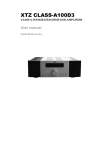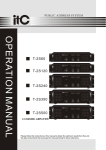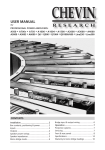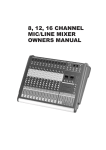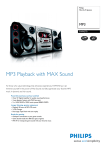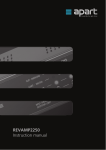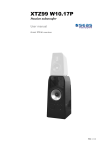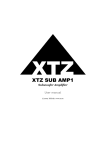Download AP100 ENG_manual_June 23
Transcript
XTZ CLASS-AP 100 CLASS A HIGH-END POWER AMPLIFIER User manual © 2009 XTZ AB , www.xtz.se Page: 1 / 13 Table of contents Page: Contents 3 About XTZ 4 Technical presentation 5 Preparations 6 Practice of sound / Installation and placement tips 7 Mounting 9 Functional reference 10 Technical specifications 13 Service & Support 14 Page: 2 / 13 Contents Contents Congratulations of your purchase of the CLASSAP100. CLASS AP100 provides many possibilities, in order to utilize this product in the best way, please read the manual carefully before using Class-AP 100. It takes patience to optimize a hifi system. If you lack experience from this kind of measurements or have any questions, please contact our “free of charge” support. (Support info on the last page of the user manual) Read the manual before using the product and use all possibilities carefully. Page: 3 / 13 About XTZ Philosophy Our reference and starting point is to reproduce a natural sound, taking into account that acoustics always is a matter of taste. XTZ Goal Our main goal is to provide the best value for money. Our concept: - Cut down the numbers of middlemen - Put more money into product quality and less on advertising. - Cost-effective manufacturing in large volumes - Provide perfect technical solutions Contact Website: www.xtz.se E-mail: [email protected] Page: 4 / 13 Technical presentation Amplifier CLASS AP100 is the first generation of this power amplifier. The amplifier is designed to provide maximum sound quality. All inputs and speaker connections are gold plated and of the highest quality. A powerful toroidal transformer contributes to an effective power supply. Four power output transistors per channel make it possible to handle high currents. The first generation is now built by modules (for future development) and has got a lot of new components with improved quality. Class A/Class AB The amplifier can be switched between class A and AB. This means you do not always have to use class Class A mode uses a higher nominal quiescent current through the output A mode if not feasible. stage, which in turn produces more heat dissipation. The output transistors heat CLASS A MODE the cooling sink, and the temperature is Class A mode increases the bias current through measured by a sensor, feeding the the output transistors to achieve the best possible information back to the output stage, thus performance. The amplifier draws a lot of power regulating the bias. even when idling, creating lots of heat dissipation There is a button for changing between making it very hot. A/AB on the front panel. CLASS AB MODE Class AB is the standard operating mode among conventional amplifiers. The maximum output power is radically higher than in Class A mode. This mode is suitable when you want to play loud for long periods. The risk of overheating is considerably lower than with class A operation. Cabinet The new cabinet, with softer corners, is almost completely made from solid aluminium, enhancing the quality impression as well as the mechanical stiffness. Outer interference is effectively shielded, and the aluminium contributes to spreading the heat generated inside. This improves the heat dissipation, cooling for the amplifier better. Page: 5 / 13 Preparations Unpacking Carefully unpack the product, and pay attention so you don't break anything. If possible, save the packing box for future transportations. Should there be any damage on the product, please contact your retailer. Check that the mains voltage marking on the back panel matches your local mains voltage. If the product is cold, wait to connect the power cord until it reaches room temperature. If you don’t do this you may cause damage of the product. Accessories Main power cord User manual Page: 6 / 13 Practice of sound / Installation and placement tips This chapter contains common information on loudspeaker placement and installation. These are general rules, so there are exceptions. In which room do you achieve the best sound? No matter how good the equipment is, in the wrong listening environment it will inevitably sound bad. There are some basic rules concerning a proper loudspeaker installation: Reflections Carpets, curtains and soft furniture absorb mid range and high frequency sounds, and this is normally preferable. Big empty areas, on the contrary, reflect it and produce hard reflections that may lead to a blurry dialogue. Apart from colouring the sound, also the perspective of the sound will deteriorate. Reflections in the room can roughly be compared to the reflections that cause ghost pictures on a TV screen. Amplification of bass A loudspeaker that is placed near a wall, ceiling or floor will amplify lower frequencies in a sometimes frequencies not desirable way (since it may lead to an indistinct sound reproduction). This amplification becomes even more obvious if the loudspeaker is placed near a corner. Thus, for a sound as clear as possible, the loudspeaker should be placed at least 30 cm (about 12 inch) away from the wall. Some constructions are designed to be placed close to a wall. Furniture Be aware that furniture may vibrate creating bad sound at loud bass levels. Room dimension Quadratic rooms or rooms where the length is exactly twice as long as the width should be avoided, since they may create unwanted resonances. Cables Try to keep them as short as possible. By its electrical parameters, a long conductor will have a bigger influence on the sound than a short one. It may also work as an antenna picking up various signals that may become a constant noise in an active subwoofer. Make sure that all connections are clean and not oxidized. All connections should be mechanically stable, both power, signal and loudspeaker cables. Signal cables should be separated from other cables. Page: 7 / 13 Front speakers To achieve the best results the front speakers should be placed symmetrically in front of the listener. The distance between the front speakers should be about 80% of the distance to the listener. In other words, the recommended angle between the front speakers is 45°. Finally Please remember that good sound is a matter of taste, so you have to experiment to obtain your favourite one. We wish you best of luck! Page: 8 / 13 Mounting Connect with the correct phase Always connect using the correct phase, from the If you by accident connect the other way, +-pole on the amplifier to the +-pole on the there is no risk of damage. However, the loudspeaker and respectively for the minus (-) pole phase of the signal will be not correct, resulting in improper sound. Overload With high power load under long time there is risk of overloading the driver and/or the amplifier. The initial playing time Amplifiers do not generally need any “playing in” Class A mode uses a higher nominal time. Class A amplifiers need a few minutes in quiescent current through the output stage, which in turn produces more heat order to stabilize the operating temperature. dissipation. The output transistors heat the cooling sink, and the temperature is measured by a sensor, feeding the information back to the output stage, thus regulating the bias. The regulation takes a few minutes before it becomes completely stable. During this time high listening volumes should be avoided. Bridge mode Using the Bridge mode, connecting the Speaker Left + and Speaker Right +. Change the switch on the rear panel to use bridge mode. Left input is used for bridge mode. Page: 9 / 13 Functional reference 1 5 3 2 7 6 11 12 13 8 10 9 15 14 1. POWER ON 2. CLASS A/AB 3. SPEAKER TERMINALS Right 4. SPEAKER TERMINALS Left 5. BALANCED INPUT Right 6. UNBALANCED INPUT Right 7. SWITCH BALANCED/UNBALANDED Right 9. 4 BALANCED INPUT Left 10. SWITCH BALANCED/UNBALANCED Left 11. TIME SET 12. ALWAYS ON/ AUTO 13. STEREO MODE/BRIDGED MODE 14. VOLTAGE 15. AC INPUT 8. UNBALANCED INPUT Left Page: 10 / 13 1 POWER ON The regulation takes a few minutes before it becomes completely stable. During this time high listening volumes should be avoided. Power on/off Green - works normally with output, Green led blinks - there is signal, but the unit does not enter work state completely. Red - standby and protect 2 CLASS A/AB Change between Class A and AB Class A mode uses a higher nominal quiescent current through the output stage, which in turn produces more heat dissipation. The output transistors heat the cooling sink, and the temperature is measured by a sensor, feeding the information back to the output stage, thus regulating the bias. The regulation takes a few minutes before it becomes completely stable. During this time high listening volumes should be avoided. Red led for Class A, Green led for Class AB 3 SPEAKER TERMINALS Right Speaker outputs 4 SPEAKER TERMINALS Left Speaker outputs 5 BALANCED INPUT Right XLR inputs. 6 UNBALANCED INPUT Right RCA inputs 7 SWITCH BALANCED/UNBAL ANCED Right To switch between balanced and unbalanced (Right) 8 UNBALANCED INPUT Left RCA inputs 9 BALANCED INPUT Left XLR inputs 10 SWITCH BALANCED/UNBAL ANCED Left To switch between balanced and unbalanced (Left) 11 TIME SET Setting the standby time 1hour, 30 min & 10 min 12 ALWAYS ON/ AUTO Switch to set Always on or Auto. When Auto is used, time set is setting the time. 13 STEREO MODE/BRIDGE MODE Switch for Stereo mode or Bridge mode 14 VOLTAGE Changing between 115V and 230 V 15 AC INPUT For the power chord Page: 11 / 13 Technical specifications Construction type Power amplifier Dimensions 158 x 445 x 468 mm (HxWxD) Inc Feet & Terminals Weight 21 kg 26kg including cardboard box SNR Ratio >105dB (A Weighted, 100W, 8ohm) Impedance (input) 20 kOhms Voltage gain 30dB Damping factor >100 AC Power supply ~220-240V & ~110-130V POWER 2x50W 2x110W 2x180W 2x350W 8 Ohm (Class A) 8 Ohm 4 Ohm 2 Ohm Bridge 1x 370W 8 Ohm 1x 500W 4 Ohm Connections Gold plated RCA, XLR Speaker output: Banana /Pole screw Page: 12 / 13 Service & support Precautions If the unit becomes unusually hot, you should immediately change the operation mode to CLASS AB by pushing the corresponding button on the front panel. This amplifier has a protection against overload and short-circuits. Also, when used under normal condition the unit becomes hot, so you should not cover it or place it in a location with reduced ventilation, i.e closed boxes or narrow areas. Do not place any other equipment on the top of the amplifier. Neither should it be placed near other sources of heat. Safety Read the manual and these precautions before taking the unit in operation. Do not expose the unit to high temperatures. Avoid placing the unit in closed racks, boxes etc. Avoid moisture, liquids and dust. Do not open the cabinet while the AC power cord is connected. Do not turn on and off the amplifier repeatedly in a short period of time. Make sure that no objects (coins, needles etc.) fall into the unit. If you plan to leave the unit unused for a longer time (when on a journey for instance), make sure the AC power cord is not connected. When connecting: Make all the necessary connections before turning the unit on. Never connect loudspeaker- or signal cables while the amplifier is turned on. Service If you need service contact your local dealer. You are always welcome to contact us if you have problems with product by e-mail: [email protected] Webpage: www.xtz.se Support Please contact our “free-of-charge” support if you need installation advice, or if any problems occur during the installation. Contact us by e-mail [email protected] and include your phone number if you require help, and we will ring you back. Guarantee This product is supplied with a ONE year guarantee against manufacturing faults or defects that might alter the performance of the unit. Refer to your supplier for full sales and guarantee terms. Page: 13 / 13 ALWAYS pack the product / part very carefully. Unfortunately damages during transportation are very common. If the package is weak, the transporting company does not compensate damages. Always enclose a copy of the receipt and a description of the defect.













